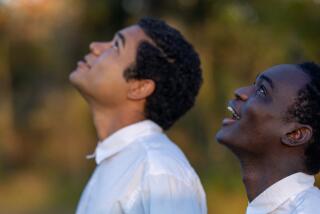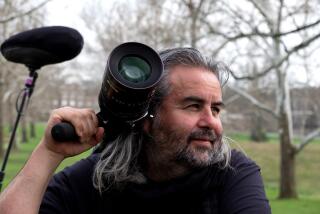Drawn to his vision
- Share via
When Roger Deakins applied to England’s National Film and Television School for the first time, the man who has become one of the world’s most respected cinematographers was informed that his stills weren’t “filmic.” Today, he sits in a sun-drenched beach cottage in Santa Monica and contemplates the concept.
“I had this big discussion with [the head of the school] the second time I applied,” says Deakins, now 58 years old. “I said, ‘The first time you said it wasn’t filmic.’ He said, ‘That one’s filmic.’ It was a dog in midair that was blurred. I said, ‘Why? That one’s blurred, because it’s got motion.’ If that’s filmic, I could have gone filmic!”
Since then, he has done precisely that. This year alone, he reteamed with Joel and Ethan Coen in a ninth effort, the widely acclaimed “No Country for Old Men,” and showed his range with the grainy desolation of “In the Valley of Elah” and the fire-lighted palette of “The Assassination of Jesse James by the Coward Robert Ford.” It’s rare for any director of photography to have three films released within weeks of one another, let alone three with this level of artistry.
The projects have put Deakins, a five-time Oscar nominee, in hot contention for yet another nod. He credits much of his success to a philosophical approach favoring meaning over empty spectacle, substance over bombast.
“I’m not attracted to a film just because it’s going to have great visuals,” Deakins says. “In fact, I find that kind of boring. There’s a line from ‘Moby-Dick’: There’s nothing so interesting as staring into the eyes of a human face. And I think that’s true. I mean, the most interesting thing is filming somebody’s face.”
For Deakins, a native of a small fishing town in England called Torquay, cinematography wasn’t the most obvious career choice, and he calls his decision to go to art school “probably the most rebellious thing to do at that time for me.” His father, who owned a construction company, wanted him to take over the family business, but Deakins’ heart belonged to painting and photography.
After graduation, Deakins found work as a documentary filmmaker, a career that called him to question what it means to film reality. “The last documentary, we shot a group of patients in a mental hospital,” he recalls. “We went to film this lady one day on the top of this high-rise. She’d been out of hospital for a couple of weeks. This woman was like in a hell of a state, absolutely drunk and being sick and screaming. There was no way I was going to film her. It really felt like being so voyeuristic. We cleaned her up, and we cooked her a meal and sat her down, and then we filmed her. But now we’re not showing what she was like. I just found that such a dilemma.”
Paradoxically, Deakins was able to discover a new kind of truth working on fiction films such as “The Shawshank Redemption,” “Dead Man Walking,” “Kundun,” “A Beautiful Mind” and his nine collaborations with the Coen brothers. “Filming Tommy Lee Jones in Ellis’ [actor Barry Corbin] cabin at the end of ‘No Country,’ it’s like you get tingles down your spine, because it’s got beauty and reality to it,” he says. “It’s the same shiver I used to get when I was shooting documentaries. It’s when you’ve got something, and you know you’re the first person to see it.”
Writer-director Paul Haggis actively sought a realistic, documentary-style look for “In the Valley of Elah,” the story of a father trying to solve the mysterious disappearance of his son, a young veteran home from Iraq. “Roger isn’t worried about it being beautiful or being lit beautifully; he’s very much serving the story,” says Haggis, who asked Deakins to film “Elah” like a John Ford classic to evoke Americana and then desaturate and gray the negatives.
Of course, truth and beauty are not always mutually exclusive. For the highly stylized meditation on celebrity “The Assassination of Jesse James,” Deakins lighted much of the film with hand-held, old-fashioned lanterns that were rigged with halogen bulbs. At the encouragement of director Andrew Dominik, Deakins went especially dramatic in the scene where Jesse and his gang rob a train. “You’ve got one lamp, and all you see is what that’s lighting: five feet,” says Deakins. “I had actually got some lights ready to hit the trees a little bit, so you get a sense of distance when Jesse was waiting for the train. And then at the last minute, a few hours before, I said, ‘I think we should really go for it.’ I put a little bit of atmosphere in the air, so when the train light comes, it blooms in smoke. It’s almost this kind of mythical appearance of light.”
Newfound synergy on the set
Illuminating big nighttime exteriors was also a challenge on “No Country for Old Men,” but Joel Coen calls Deakins “one of the world’s great DPs in terms of how he lights.” The Coen brothers started their collaboration with Deakins after their previous cinematographer -- Barry Sonnenfeld -- decided to pursue a directing career. “With Barry, we were often working in very small depth of field, and he lights with hard fixtures,” Joel Coen says. “Barry was a very interesting and talented DP, but working with Roger was liberating in terms of what we were able to do in terms of blocking and moving the camera. And Roger doesn’t vomit on the set like Barry does. Barry shares to a fault. Roger, less so.”
It’s a good thing Deakins has a strong stomach, because he’s booked for the foreseeable future with high-profile projects such as Sam Mendes’ “Revolutionary Road” and John Patrick Shanley’s “Doubt.” And while Deakins’ chief visual hallmark may be his versatility, the films he works on do tend to have at least one unifying trait.
“Frankly, I would love it if everything I ever worked on had some social relevance,” he says. “That’s what I think it’s really about. If you don’t have something in the frame that’s worth shooting, then I don’t know why you would want to do it, really. That’s why I feel so lucky to have worked on these ones this year.”
More to Read
Only good movies
Get the Indie Focus newsletter, Mark Olsen's weekly guide to the world of cinema.
You may occasionally receive promotional content from the Los Angeles Times.










